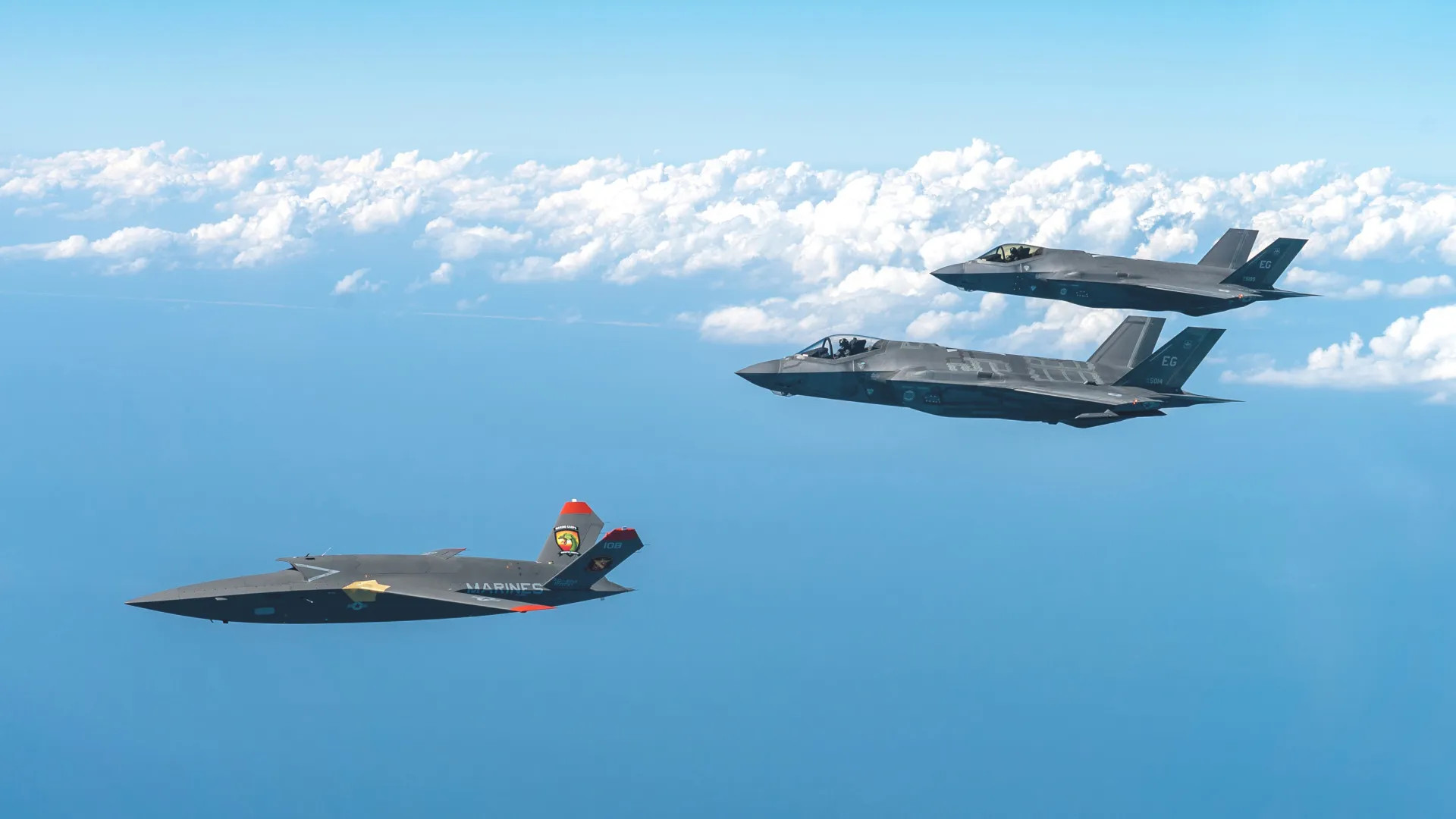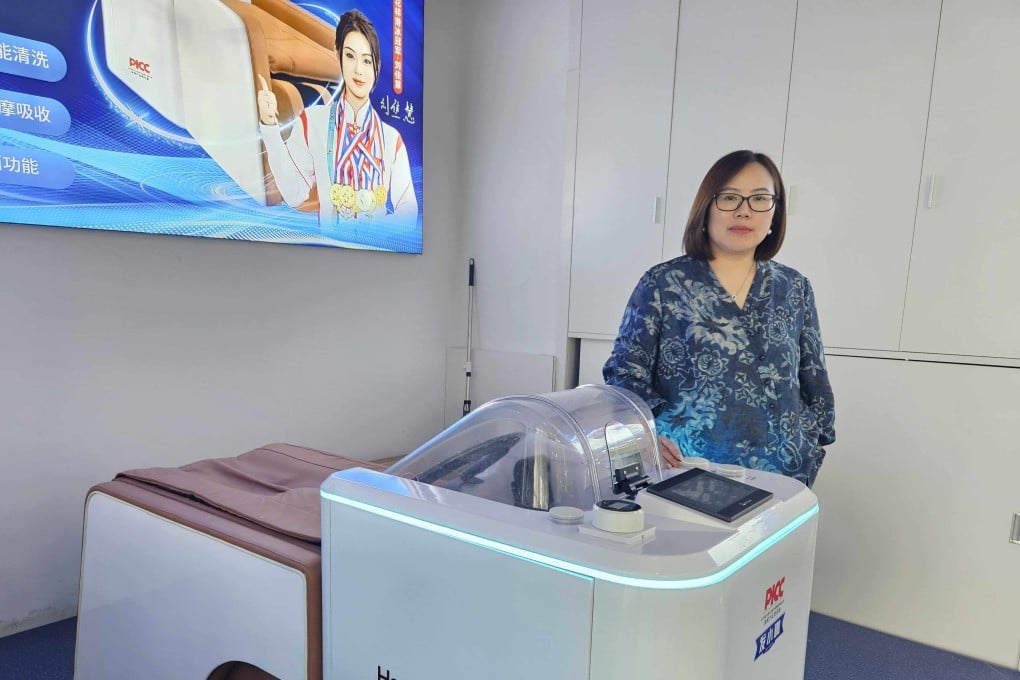Ensuring future Collaborative Combat Aircraft (CCA) drones can fly in close proximity to friendly crewed aircraft without colliding with each other remains a major challenge, according to the U.S. Marine Corps.
This is just one of many basic operational problems facing the Marines, as well as the U.S. Air Force and the U.

S. Navy, when it comes to how future CCAs will be deployed, launched, recovered, supported, and otherwise operated, let alone employed tactically. The Marines have taken on a particularly important role in working to address these issues.
Col. Derek Brannon, director of the Marine Corps’ Cunningham Group, discussed his service’s work related to CCAs during a talk earlier today at the annual Modern Day Marine exposition, at which TWZ was in attendance. The Cunningham Group sits within the office of the Deputy Commandant for Aviation and is in charge of plotting out the overarching future vision for Marine Corps aviation.
A Marine Corps XQ-58A Valkyrie drone, which the service has been using to explore crewed-uncrewed teaming concepts of operations, on display at the 2025 Modern Day Marine exposition. Howard Altman “Let’s get this thing out there. Let’s start integrating.
Let’s then start working to [sic] warfighting functions of our CCA, and move forward,” Brannon said, describing his service’s current focus. “It’s an exceptional piece of capability.”Right now, the Marines are using a small group of Kratos XQ-58A Valkyrie drones to experiment with crewed-uncrewed teaming concepts as part of what the service has dubbed the Penetrating Affordable Autonomous Collaborative Killer-Portfolio (PAACK-P).
One particular known area of focus for the Marines has centered on using those drones as electronic warfare platforms in conjunction with F-35s. U.S.
Air Force F-35A and F-16C fighters have participated in PAACK-P flight tests staged out of Eglin Air Force Base in Florida.A Marine XQ-58A flies together with a US Air Force F-16. USAF At the same time, “we still have a lot to learn to simply get to this thing airborne, flying, and executing next to an F-35, and not hitting each other,” he added.
“I know there’s a lot of work out there, but that’s important to make sure that we become lethal.”Brannon’s comments here reflect core challenges the Air Force has also been openly working to address, as well. Last year, the Air Force announced that its X-62A test jet running on an artificial intelligence (AI) ‘brain’ had successfully engaged in a mock dogfight with a crewed F-16, a real and significant breakthrough for autonomous air combat.
The X-62A is a highly specialized two-seat F-16D that continues to be modified to support expanding work on advanced autonomy and other next-generation capabilities. However, it subsequently emerged that the two aircraft in the Air Force’s simulated dogfight were directly exchanging data the entire time. This highlighted important situational awareness limitations for autonomous platforms at present when it comes to other friendly aircraft, let alone a non-cooperative hostile threat, as you can read more about in detail here.
The commercial and military aviation sectors have been developing and fielding increasingly more capable automated ‘sense and avoid’ systems for decades now, with those developments now increasingly filtering into work on new and existing uncrewed aircraft. The Marine Corps itself is currently working to integrate a Detect and Avoid System (DAAS) onto its MQ-9 Reaper drones. At the same time, these developments are largely centered on flight operations in controlled airspace rather than the far more dynamic operations CCAs will be called upon to conduct.
A March 2025 Naval Air Systems Command briefing slide detailing current (at left) and planned future capabilities (at right), the latter including the Detect And Avoid System, for Marine MQ-9s. USN Shield AI is one company now working to more directly address core autonomous piloting questions, including with an eye toward U.S.
military CCA efforts. In an interview last year, Brandon Tseng, Shield AI’s co-founder, president, and chief growth officer, told TWZ:“I tell people that self-driving technology for aircraft enables mission execution, with no remote pilot, no communications, and no GPS. It enables the concept of teaming or swarming where these aircraft can execute the commander’s intent.
They can execute a mission, working together dynamically, reading and reacting to each other, to the battlefield, to the adversarial threats, and to civilians on the ground.”..
.“The other value proposition I think of is the system – the fleet of aircraft always gets better. You always have the best AI pilot on an aircraft at any given time.
We win 99.9% of engagements with our fighter jet AI pilot, and that’s the worst that it will ever be, which is superhuman. So when you talk about fleet learning, that will be on every single aircraft, you will always have the best quadcopter pilot, you’ll always have the best V-BAT pilot, you’ll always have the best CCA pilot, you name it.
It’ll be dominant. You don’t want the second best AI pilot or the third best, because it truly matters that you’re winning these engagements at incredibly high rates.”Col.
Brannon’s comments today are something of a reality check for where these fundamental development efforts are currently and the challenges that need to be addressed to make larger CCA concepts a reality. If crewed aircraft just flying together with CCAs in a test environment is still an issue, then that says something about meeting more complex demands even during routine peacetime operations.Overall, the general vision for CCAs across the U.
S. military involves employin very large numbers of them to help increase overall combat capacity in a more affordable manner. The goal is also for drones in this category to be able to provide that ‘affordable mass’ without significantly increased personnel or logistics demands.
All of this, in turn, opens avenues to new tactics, techniques, and procedures that, by extension, create new dilemmas for adversaries.Col. Brannon laid out a scenario involving Marine forces flying “an entire assault package into a hot LZ [landing zone] or in a contested environment, controlling CCA, managing the capabilities that are airborne, and not having to rely with [sic; on] manned TACAIR [tactical aviation; fighters].
” This also points to more independent CCA operations, which will demand greater autonomous capabilities. The video below from Collins Aerospace offers a look at how congested the skies may get in a future conflict involving U.S.
CCAs teamed up with crewed fighters.Brannon also made clear that he sees CCAs, whether they belong to the Marines or other services, as a critical component of future operations, saying “we just don’t have the capacity to support” them with crewed TACAIR alone.In addition, the comments today from the Cunningham Group underscore the leading role the Marines look to be taking in the development of concepts of operations and tactics, techniques, and procedures for employing CCAs across the U.
S. military. “We are also leading the way with incorporating Collaborative Combat Aircraft (CCAs) with the F-35 by pushing research and development efforts towards this front,” the Marine Corps declared in its most recent Aviation Plan, released in February.
Navy Rear Adm. Michael “Buzz” Donnelly, Director of the Air Warfare Division (N98) within the Office of the Chief of Naval Operations, also highlighted this at the Navy League’s annual Sea Air Space symposium earlier this month.“The United States Navy is in a tri-service memorandum of agreement and understanding with our sister services, the U.
S. Air Force, as well as the Marine Corps, and we are developing that capability together. Each of us are focused on a different aspect of that,” Donnelly said at the time.
“The Air Force is leading and very forward leaning in the development of the actual air vehicle and the autonomy that goes in those for execution of mission. Marine Corps is working closely to develop manned-unmanned teaming between platforms such as the F-35, the F-35B being the baseline for their aviation capability right now. And the United States Navy is working based on our pathway of unmanned into the fleet with MQ-25.
”“As we work together for the United States Navy, I will tell you that we are definitely in the follow of those three services,” he added.When it comes to what a future Marine CCA fleet might actually look like going forward, that is still very much an open question. It is also directly tied to the service’s still-evolving plans for a new drone to more directly supplement or supplant its MQ-9s as part of the Marine Air Ground Task Force Unmanned Aircraft System Expeditionary program, or MUX.
A Marine Corps MQ-9 Reaper. USMC “Variations of MUX MALE Next may be a TACAIR CCA with a certain set of attributes, followed by a smaller Group 3 size [drone], but be able to take what a MUX MALE Next was intended to do, but fill gaps with capabilities that continue to improve, especially in our smaller unmanned systems,” Col. Brannon said.
The Marine Corps’ original vision for the MUX concept, outlined in the late 2010s, consisted of multiple advanced drone types capable of performing airborne early warning, air reconnaissance, electronic warfare, communications relay, offensive air support, scout and aerial escort, and cargo carrying missions, as you can read more about here. The Marines subsequently scaled back their near-term uncrewed aviation plans significantly and acquired the MQ-9 as the initial MUX platform.An early “operational view” of the proposed MUX drone family and its mission sets.
USMC There has been discussion about operationalizing the XQ-58A to meet Marine Corps needs based on experience gained through PAACK-P.“The XQ-58A Valkyrie test flights and the data collected inform future requirements for the Marine Corps in a rapidly evolving security environment, while successfully fueling joint innovation and experimentation opportunities. Future test flights inform Marine Corps XQ-58A Valkyrie requirements for the Marine Air-Ground Task Force Unmanned Aerial System Expeditionary (MUX) Tactical Aircraft (TACAIR),” the Marine Corps has told TWZ in the past.
“The XQ-58A Valkyrie is an experimental aircraft that provides the Marine Corps with a testbed platform for developing technologies and new concepts in support of the Marine Air Ground Task Force, such as autonomous flight and unmanned teaming with crewed aircraft.”The Marines could also look to leverage airframes emerging from the Air Force’s CCA program. General Atomics and Anduril are currently developing what are now designated the YQ-42A and YFQ-44A, respectively, as part of Increment 1 of the Air Force’s CCA effort.
The service is planning to evaluate additional designs in a second increment, which is expected to have significantly different core requirements. Further iterative development phases may follow. A composite rendering of the General Atomics YFQ-42A and Anduril YFQ-44A drones.
General Atomics/Anduril As noted, the Navy has already said it is very much following the Air Force and Marines on the CCA front, including in the development of potential airframes.In the meantime, the Marines look set to continue laying the groundwork for how it, as well as the Air Force and Navy, will actually employ CCAs, including reducing the risk of them colliding with their crewed companions. Contact the author: joe@twz.
comThe post Making Sure Wingman Drones Don’t Hit Their Crewed Companions Still A Challenge Marines Say appeared first on The War Zone..
Technology

Making Sure Wingman Drones Don’t Hit Their Crewed Companions Still A Challenge Marines Say

The post Making Sure Wingman Drones Don’t Hit Their Crewed Companions Still A Challenge Marines Say appeared first on The War Zone.















